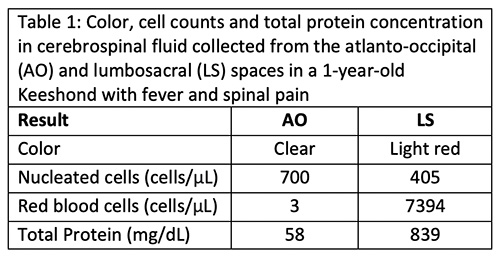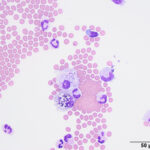Cerebrospinal fluid from a dog
Case Information
A 1-year-old intact male Keeshond was presented to the Emergency Service in the Cornell University Hospital for Animals (CUHA) with persistent fever and neck or spinal pain of three weeks duration. The dog had shown reluctance to walk up or down stairs or jump on or off furniture. A hemogram revealed an inflammatory leukogram, consisting of a mild neutrophilia (17.8 thou/µL; reference interval, 2.0-12.0 thou/µL) and mild to moderate monocytosis (3.9 thou/µL, 0.3-2.0 thou/µL). The clinical signs were not alleviated by antibiotics and pain medications, including gabapentin and carprofen. Testing for tick-borne diseases and heartworm was negative and cervical radiographs showed no abnormalities. On physical examination at CUHA, the dog was bright, alert, and responsive, but was anxious and febrile (104.8°F). Pain was elicited on manipulation of the neck and palpation of the spinal column. Gait analysis revealed a left forelimb lameness with a positive withdrawal reflex and pain on manipulation of the elbow. Proprioception could not be assessed because the dog would not bear weight on that limb. The other limbs had intact reflexes and normal proprioception. Cerebrospinal fluid (CSF) was collected from the atlanto-occipital (AO) and lumbosacral (LS) spaces. Results are shown below (Table 1) with representative images from cytospin smears (Figures 1-2). Examine the results then answer the questions.
- What cell types are present in the fluid from both sites?
- What is your top differential diagnosis, given the presenting clinical signs and CSF findings?
|
|
Answers on next page



